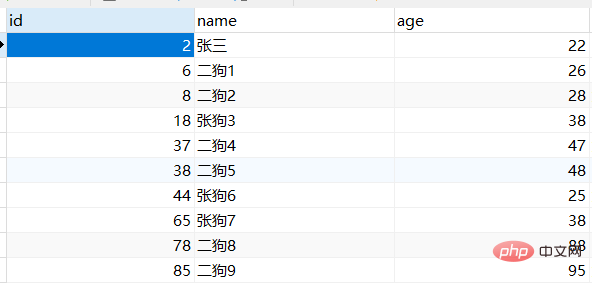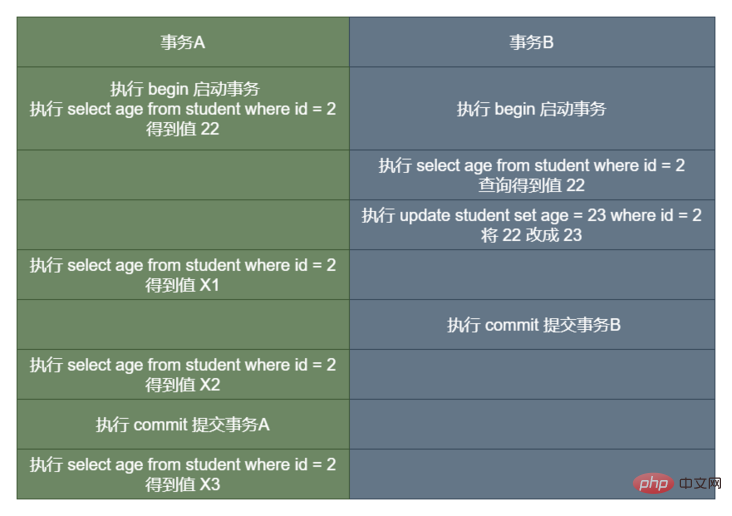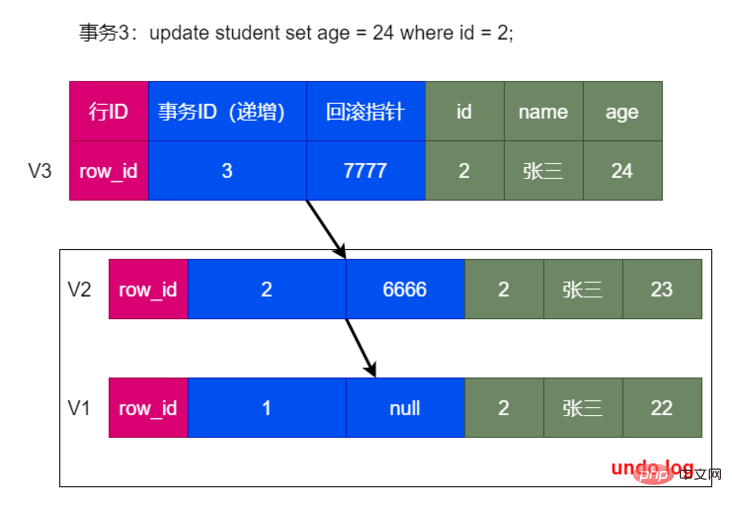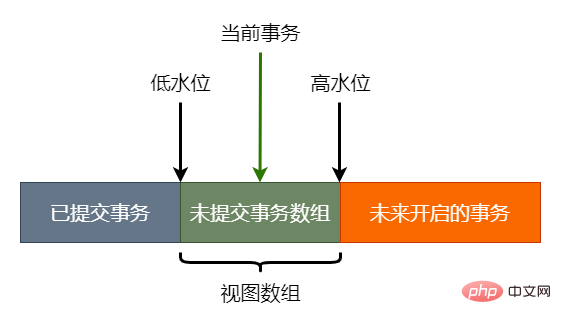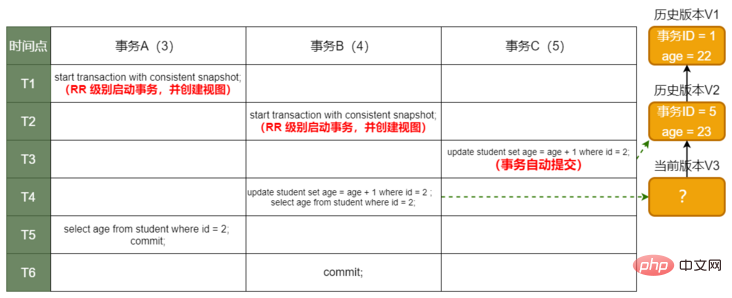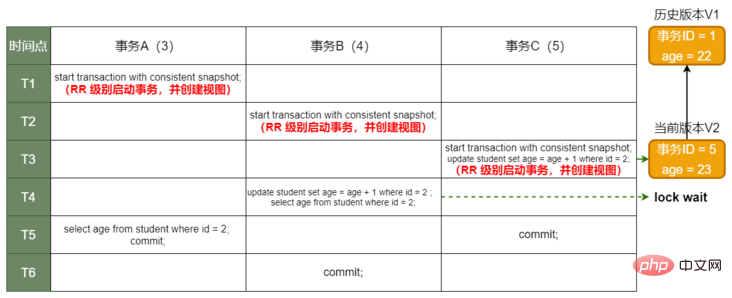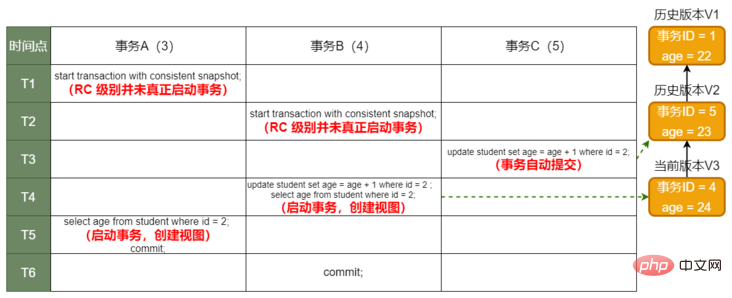 Database
Database
 Mysql Tutorial
Mysql Tutorial
 An article explaining the principles of transactions and MVCC in MySQL in detail
An article explaining the principles of transactions and MVCC in MySQL in detail
An article explaining the principles of transactions and MVCC in MySQL in detail
This article will take you to understand the transactions in MySQL and introduce the principle of MVCC. I hope it can help you!

#01 What is a transaction?
Database transaction refers to a set of data operations. The operations within the transaction are either all successful or all failed. Nothing is done. In fact, it is not that nothing is done. It is possible that some of it is done, but as long as If one step fails, all operations must be rolled back, which is a bit of a non-stop operation.
In MySQL, transaction support is implemented at the engine layer. MySQL is a system that supports multiple engines, but not all engines support transactions. For example, MySQL's native MyISAM engine does not support transactions, which is one of the important reasons why MyISAM was replaced by InnoDB.
1.1 Four major characteristics
- Atomicity: After the transaction starts, all operations are either completed or completed If you don’t do it, you won’t be stuck in the middle. If an error occurs during transaction execution, it will be rolled back to the state before the transaction started, and all operations will be as if they did not happen. That is to say, affairs are an indivisible whole, just like atoms learned in chemistry, which are the basic units of matter.
- Consistency: Before and after the transaction starts and ends, the integrity constraints of the database are not violated. For example, when A transfers money to B, it is impossible for A to deduct the money but B not to receive it.
- Isolation: Only one transaction is allowed to request the same data at the same time, and there is no interference between different transactions. For example, A is withdrawing money from a bank card. B cannot transfer money to this card before A's withdrawal process is completed.
- Durability (Durability): After the transaction is completed, all updates to the database by the transaction will be saved to the database and cannot be rolled back.
1.2 Isolation level
Among the four major characteristics of SQL transactions, atomicity, consistency, and durability are all relatively easy to understand. But the isolation level of transactions is indeed difficult. Today we will mainly talk about the isolation of MySQL transactions.
SQL standard transaction isolation from low to high levels are: read uncommitted (read uncommitted), read committed (read committed), repeatable read (repeatable read) and serializable (serializable) ). The higher the level, the lower the efficiency.
- Read uncommitted: When a transaction has not been committed, the changes it makes can be seen by other transactions.
- Read commit: After a transaction is committed, the changes it makes will be seen by other transactions.
- Repeatable read: The data seen during the execution of a transaction is always consistent with the data seen when the transaction is started. Of course, under the repeatable read isolation level, uncommitted changes are also invisible to other transactions.
- Serialization: As the name implies, for the same row of records, "write" will add a "write lock", and "read" will add a "read lock". When a read-write lock conflict occurs, the transaction accessed later must wait for the completion of the previous transaction before it can continue to execute. So all data under this isolation level is the most stable, but the performance is also the worst.
1.3 Solved concurrency issues
SQL transaction isolation level is designed to solve concurrency issues to the greatest extent:
- Dirty read: Transaction A reads the data updated by transaction B, and then B rolls back the operation, then the data read by A is dirty data
- Non-repeatable read: Transaction A has more When transaction A reads the same data multiple times, transaction B updates and submits the data, resulting in inconsistent results when transaction A reads the same data multiple times.
- Phantom reading: System administrator A changed the grades of all students in the database from specific scores to ABCDE grades, but system administrator B inserted a record of specific scores at this time. When system administrator A After the modification is completed, I find that there is still one record that has not been modified, as if I have hallucinated. This is called phantom reading.
SQL Different transaction isolation levels can solve different concurrency problems, as shown in the following table: Only the serialized isolation level solves all three problems, and the other 3 Each isolation level has flaws.
| Transaction isolation level | Dirty read | Non-repeatable read | Phantom read |
|---|---|---|---|
| Read Uncommitted | Possible | Possible | Possible |
| Read Committed | Impossible | Possible | Possible |
| Repeatable Read | Impossible | impossible | possible |
| impossible | impossible | impossible |
The above is the detailed content of An article explaining the principles of transactions and MVCC in MySQL in detail. For more information, please follow other related articles on the PHP Chinese website!

Hot AI Tools

Undresser.AI Undress
AI-powered app for creating realistic nude photos

AI Clothes Remover
Online AI tool for removing clothes from photos.

Undress AI Tool
Undress images for free

Clothoff.io
AI clothes remover

Video Face Swap
Swap faces in any video effortlessly with our completely free AI face swap tool!

Hot Article

Hot Tools

Notepad++7.3.1
Easy-to-use and free code editor

SublimeText3 Chinese version
Chinese version, very easy to use

Zend Studio 13.0.1
Powerful PHP integrated development environment

Dreamweaver CS6
Visual web development tools

SublimeText3 Mac version
God-level code editing software (SublimeText3)

Hot Topics
 MySQL: An Introduction to the World's Most Popular Database
Apr 12, 2025 am 12:18 AM
MySQL: An Introduction to the World's Most Popular Database
Apr 12, 2025 am 12:18 AM
MySQL is an open source relational database management system, mainly used to store and retrieve data quickly and reliably. Its working principle includes client requests, query resolution, execution of queries and return results. Examples of usage include creating tables, inserting and querying data, and advanced features such as JOIN operations. Common errors involve SQL syntax, data types, and permissions, and optimization suggestions include the use of indexes, optimized queries, and partitioning of tables.
 MySQL's Place: Databases and Programming
Apr 13, 2025 am 12:18 AM
MySQL's Place: Databases and Programming
Apr 13, 2025 am 12:18 AM
MySQL's position in databases and programming is very important. It is an open source relational database management system that is widely used in various application scenarios. 1) MySQL provides efficient data storage, organization and retrieval functions, supporting Web, mobile and enterprise-level systems. 2) It uses a client-server architecture, supports multiple storage engines and index optimization. 3) Basic usages include creating tables and inserting data, and advanced usages involve multi-table JOINs and complex queries. 4) Frequently asked questions such as SQL syntax errors and performance issues can be debugged through the EXPLAIN command and slow query log. 5) Performance optimization methods include rational use of indexes, optimized query and use of caches. Best practices include using transactions and PreparedStatemen
 How to connect to the database of apache
Apr 13, 2025 pm 01:03 PM
How to connect to the database of apache
Apr 13, 2025 pm 01:03 PM
Apache connects to a database requires the following steps: Install the database driver. Configure the web.xml file to create a connection pool. Create a JDBC data source and specify the connection settings. Use the JDBC API to access the database from Java code, including getting connections, creating statements, binding parameters, executing queries or updates, and processing results.
 Why Use MySQL? Benefits and Advantages
Apr 12, 2025 am 12:17 AM
Why Use MySQL? Benefits and Advantages
Apr 12, 2025 am 12:17 AM
MySQL is chosen for its performance, reliability, ease of use, and community support. 1.MySQL provides efficient data storage and retrieval functions, supporting multiple data types and advanced query operations. 2. Adopt client-server architecture and multiple storage engines to support transaction and query optimization. 3. Easy to use, supports a variety of operating systems and programming languages. 4. Have strong community support and provide rich resources and solutions.
 How to start mysql by docker
Apr 15, 2025 pm 12:09 PM
How to start mysql by docker
Apr 15, 2025 pm 12:09 PM
The process of starting MySQL in Docker consists of the following steps: Pull the MySQL image to create and start the container, set the root user password, and map the port verification connection Create the database and the user grants all permissions to the database
 MySQL's Role: Databases in Web Applications
Apr 17, 2025 am 12:23 AM
MySQL's Role: Databases in Web Applications
Apr 17, 2025 am 12:23 AM
The main role of MySQL in web applications is to store and manage data. 1.MySQL efficiently processes user information, product catalogs, transaction records and other data. 2. Through SQL query, developers can extract information from the database to generate dynamic content. 3.MySQL works based on the client-server model to ensure acceptable query speed.
 Laravel Introduction Example
Apr 18, 2025 pm 12:45 PM
Laravel Introduction Example
Apr 18, 2025 pm 12:45 PM
Laravel is a PHP framework for easy building of web applications. It provides a range of powerful features including: Installation: Install the Laravel CLI globally with Composer and create applications in the project directory. Routing: Define the relationship between the URL and the handler in routes/web.php. View: Create a view in resources/views to render the application's interface. Database Integration: Provides out-of-the-box integration with databases such as MySQL and uses migration to create and modify tables. Model and Controller: The model represents the database entity and the controller processes HTTP requests.
 How to install mysql in centos7
Apr 14, 2025 pm 08:30 PM
How to install mysql in centos7
Apr 14, 2025 pm 08:30 PM
The key to installing MySQL elegantly is to add the official MySQL repository. The specific steps are as follows: Download the MySQL official GPG key to prevent phishing attacks. Add MySQL repository file: rpm -Uvh https://dev.mysql.com/get/mysql80-community-release-el7-3.noarch.rpm Update yum repository cache: yum update installation MySQL: yum install mysql-server startup MySQL service: systemctl start mysqld set up booting



